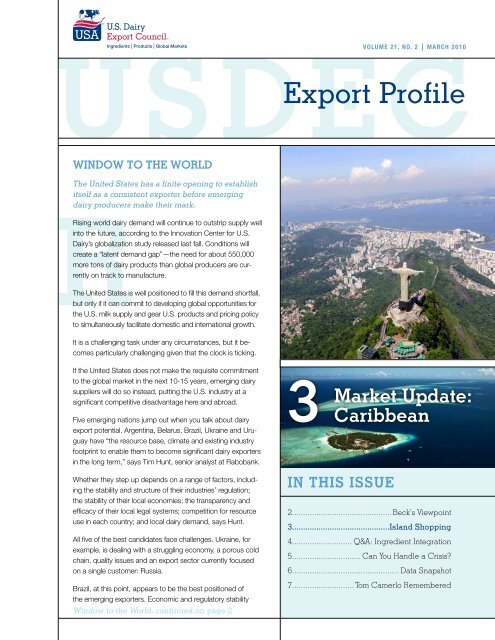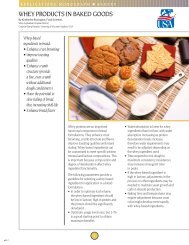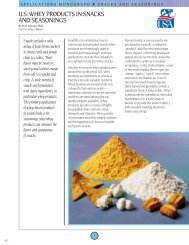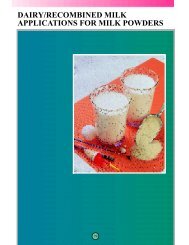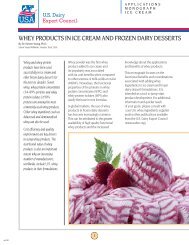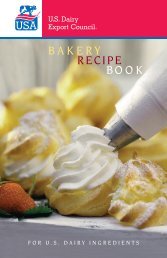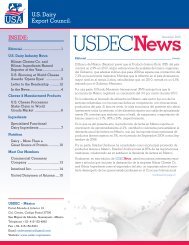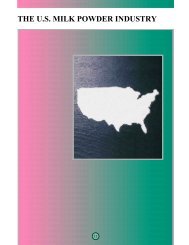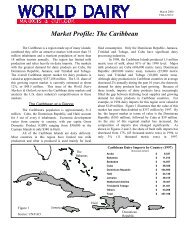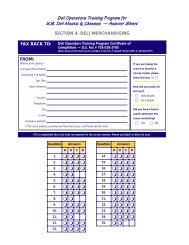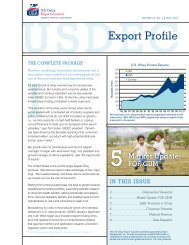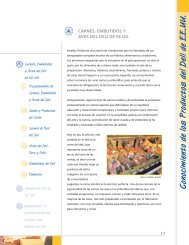Export Profile - US Dairy Export Council
Export Profile - US Dairy Export Council
Export Profile - US Dairy Export Council
You also want an ePaper? Increase the reach of your titles
YUMPU automatically turns print PDFs into web optimized ePapers that Google loves.
Volume 21, No. 2 March 2010<strong>Export</strong> <strong>Profile</strong>Window to the WorldThe United States has a finite opening to establishitself as a consistent exporter before emergingdairy producers make their mark.RRising world dairy demand will continue to outstrip supply wellinto the future, according to the Innovation Center for U.S.<strong>Dairy</strong>’s globalization study released last fall. Conditions willcreate a “latent demand gap”—the need for about 550,000more tons of dairy products than global producers are currentlyon track to manufacture.The United States is well positioned to fill this demand shortfall,but only if it can commit to developing global opportunities forthe U.S. milk supply and gear U.S. products and pricing policyto simultaneously facilitate domestic and international growth.It is a challenging task under any circumstances, but it becomesparticularly challenging given that the clock is ticking.If the United States does not make the requisite commitmentto the global market in the next 10-15 years, emerging dairysuppliers will do so instead, putting the U.S. industry at asignificant competitive disadvantage here and abroad.Five emerging nations jump out when you talk about dairyexport potential. Argentina, Belarus, Brazil, Ukraine and Uruguayhave “the resource base, climate and existing industryfootprint to enable them to become significant dairy exportersin the long term,” says Tim Hunt, senior analyst at Rabobank.3MarketUpdate:CaribbeanWhether they step up depends on a range of factors, includingthe stability and structure of their industries’ regulation;the stability of their local economies; the transparency andefficacy of their local legal systems; competition for resourceuse in each country; and local dairy demand, says Hunt.All five of the best candidates face challenges. Ukraine, forexample, is dealing with a struggling economy, a porous coldchain, quality issues and an export sector currently focusedon a single customer: Russia.Brazil, at this point, appears to be the best positioned ofthe emerging exporters. Economic and regulatory stabilityWindow to the World, continued on page 2In This Issue2.............................................Beck’s Viewpoint3............................................Island Shopping4........................... Q&A: Ingredient Integration5............................... Can You Handle a Crisis?6................................................ Data Snapshot7............................Tom Camerlo Remembered
MarketUpdate: CaribbeanIsland ShoppingDomestic demand and tourism swellCaribbean cheese imports and dairyconsumption.As a bloc, the Caribbean is a key global importer whosedomestic dairy sector, due to land constraints, willnever be able to meet rising demand for cheese, milkand other products. It boasts a population of more than36 million, and welcomes 16 million vacationers andmillions more cruise ship visitors each year (not includingPuerto Rico).In addition, U.S. dairy suppliers not only hold a geographicedge over their counterparts from Oceania and theEuropean Union (EU), they hold a marketing advantage.“Caribbean consumers, particularly those closer to themainland, are cognizant of U.S. brands,” says DiahannSmith, <strong>US</strong>DEC’s Caribbean office representative. “Mostof the Caribbean is connected to our mainland via TV andthe Internet, and they are in tune with our trends. Theywant to try the newest recipes they see on food showsand they are exposed to mainland media campaigns.”Even during an economically challenging 2009 whenthe region’s GDP fell 2 percent and its four biggestmoneymakers—financial services, real estate, tourismand remittances—all declined, overall dairy consumptionand imports proved resilient.Total U.S. dairy shipments to the Caribbean, whiledown, performed better than other key export markets,and U.S. cheese sales to the region grew 4 percent to9,100 tons in 2009. Four nations—Bahamas, DominicanRepublic, Jamaica and Trinidad & Tobago—rankedamong the top 15 U.S. cheese export destinations.Combined, they stood as the No. 4 U.S. cheese exportmarket behind Mexico, Canada and South Korea.Despite stiff competition from New Zealand and the EU,U.S. market share by island ranged from 15 percent inTrinidad & Tobago to 88 percent in the Bahamas, andstood at about 33 percent for the region as a whole.Looking ahead, there is plenty to get excited about inthe Caribbean. Tourism, which is a big demand driver,particularly in the hotel, restaurant and institutionalsector, improved as the year went on, with countriessuch as the Dominican Republic and U.S. Virgin Islands<strong>US</strong>DEC chef-to-chef workshops seek to demonstrate U.S.cheese applications, taste and functionality and keep U.S.cheeses top-of-mind with food professionals.even posting gains in the fourth quarter after strugglingearly in the year.Economic conditions are improving. The DominicanRepublic, Barbados and Trinidad & Tobago have allshown signs of a quick rebound.And U.S. suppliers could get a new customer in theregion if the United States continues to push legislationto revise current ag export payment provisions andends its decades-old travel ban with Cuba.Whether or not Cuba returns as a long-term U.S.buyer, suppliers can take action to improve their positionin the Caribbean.“U.S. suppliers need to visit and understand the variedmarket preferences. While people are familiar with U.S.dairy, many are loyal to their European roots. And thereis a need for cheddar with taste and texture similar toNew Zealand’s and increased interest in gouda made inthe United States,” says Smith.With a return to economic growth, continued recoveryin tourism and greater focus by the U.S. industry, theCaribbean could move even higher on the list of topU.S. cheese buyers.The year is off to a good start. Although it’s only a singlemonth, January 2010 U.S. export value to the Caribbeanmore than doubled.March 2010 Page 3
Q&A: Ingredient IntegrationWith Jerry O’DeaQ: How has globalizationaffected the dairyingredient business overthe past decade?JO: Much has changed overthe past 10 years. We haveseen a host of acquisitionactivity across all sectors ofthe food industry, with largeglobal players acquiringregional or niche players.In many cases, these largecompanies have moved toward global purchasing anddevelopment programs. In response, dairy ingredientcompanies are operating globally, setting up salesand service centers around the world to better servicetheir global customers. Many are acquiring suitablepartners internationally to provide a more extensiverange of ingredients and services, or are moving intonew milk producing regions and setting up processingoperations to leverage their manufacturing capability.Q: What sparked the changes?JO: Demand has grown significantly. For instance,China and Southeast Asia have quickly becomemajor consumers of dairy ingredients. Changes inthe political, economic and environmental landscapeof that region now impact the global supply/demanddynamic, whereas that wasn’t the case 10 years ago.Dealing with price volatility is now a major part of the“Day Job” of dairy executives.Q: Why is it important to have a global market viewwhen it comes to dairy ingredients?JO: Food trends have become more international,providing a greater opportunity to commercializeingredient innovations globally. In addition, more isexpected of ingredient suppliers in today’s more competitivemarketplace. To effectively compete, ingredientcompanies must be solutions providers as opposedto simply ingredient suppliers. That means ingredientcompanies need to come armed with more knowledgeof the consumer market, have good formulationscapability and provide ingredients in a form that isclose to market ready. To recover the associated costsof this new paradigm, ingredient companies must beable to leverage their competency on a global basis.Q: How does that relate to the merging of DMI’sdomestic ingredients program and <strong>US</strong>DEC’sexport program into a single global ingredientsmarketing initiative?JO: The U.S. dairy industry needs to be wellresourced and coordinated to excel in this newera. The integration of the ingredient programsmakes a lot of sense in this context—they mustbe structured globally to support the U.S. dairyindustry in today’s environment.Q: What actions do U.S. dairy ingredient suppliersneed to take now to ensure that they can compete ona global level in the future?JO: To be successful U.S. companies need to ensurethey understand where the international market(U.S. and overseas) is heading in terms of productand ingredient preference. They need to gear up toprovide ingredients with the appropriate in-marketsupport that customers need, all in a cost-effectiveway. As an industry we need to remove any structuralimpediments that prevent us from competingeffectively. We also need to continue to refine ourmarketing/research and development in line withrapidly changing market needs.Jerry O’Dea is president and CEO of GlanbiaNutritionals <strong>US</strong>A, Madison, Wis.Page 4Managed by <strong>Dairy</strong> Management Inc.
Events: Crisis DrillAre You Preparedfor A Crisis?Drills test your company’s response to foodsafety emergencies.Last year, the U.S. Food and Drug Administrationand U.S. Department of Agriculture together reportedmore than 850 food recalls (most with multiple items).Between Plainview Milk Products Cooperative’s warningabout a host of products made with its NDM and wheyand a variety of companies recalling ice cream becauseof links to tainted peanuts and pistachios, dairyproducts featured prominently.The circumstances of the events—in both cases, itwasn’t the dairy component of the product that wascontaminated but third-party ingredients—helped the industryescape with little to no backlash. Good news, butalso alarming in its own right: The instances illustratedthat food safety crises can affect your operations even ifyou maintain the most stringent quality measures.“The drill quickly got us intothe mindset of crisis managementand brought top-of-mindwhat we must include in ourplans—and how most of usare not prepared.”– 2009 attendeeThe lesson: It is imperative to be crisis-ready.This year, you can test your preparedness at one ofthree regional dairy industry crisis drills. The WesternRegion Crisis Drill is slated for March 31 in Seattle, withothers to follow July 22 in Atlanta and early Novemberin Dallas.The crisis drills are sponsored by <strong>US</strong>DEC, along with<strong>Dairy</strong> Management Inc., International <strong>Dairy</strong> FoodsAssociation, Milk Processor Education Program andNational Milk Producers Federation. These organizationshave worked together since 2001 on a joint crisiscommunications plan designed to protect public healthand consumer confidence in dairy in the event of alarge-scale crisis.The full-day drills, which were launched in 2009, featurea realistic food-safety scenario that will test your crisisteam’s skills and preparedness in communications, operationsand management. Attendees typically includecommunications and quality assurance experts fromdairy manufacturers and co-ops; federal, regional andstate government officials; and communicators fromstate and regional dairy check-off organizations.“This was one of the most masterfuland tightly coordinated tabletop drillsI’ve ever experienced. The facilitatorskept the breakout sessions on targetand on time. The email and phone‘feeds’ kept everyone engaged.”– 2009 attendeeThose interested in attending a drill should visit theWestern Region Drill Microsite by clicking here orby contacting Margaret Speich at 703-469-2363,mspeich@usdec.org. Space is limited.Crisis Drill Agenda8:20 The crisis begins: Government announcement leadsto global headlines and consumer concern.8:40 How will your company respond? Emergencyresponse center (ERC) simulations.10:00 Challenge breakout sessions: Test and build yourcrisis response skills and knowledge11:05 Fictional company ERCs12:05 United we stand: Government, industry associationand private sector coordination in a crisis12:50 The crisis escalates: New information broadensimpact and deepens consumer outrage1:00 How will your company respond?ERC simulations2:00 ERC team reports2:35 Winning back the market: Rebuilding and recovery3:40 Working together if the unthinkable happens3:50 Crisis readiness: What’s your next step?March 2010 Page 5
DataSnapshotU.S. dairy export performance improved significantlyin the fourth quarter, but overall volume declined by 16percent to 2.178 billion lbs. of milk solids (total solidsbasis). <strong>Export</strong> volume represented 9.3 percent of milkproduction in 2009, down from 11 percent in 2008 and9.8 percent in 2007.SMP <strong>Export</strong>s Jan. – Dec. (volume, MT)Country 2008 2009 % changeNZ 242,012 407,993 +69<strong>US</strong> 391,165 248,829 -36EU-27 176,600 226,500 +28Australia 124,459 166,804 +34SUBTOTAL 934,236 1,050,126 +12Whey Products <strong>Export</strong>s Jan. – Dec. (volume, MT)Country 2008 2009 % changeEU-27 326,100 386,900 +19<strong>US</strong> 334,351 350,975 +5Australia 59,953 66,246 +10Argentina 30,726 33,981 +11NZ 18,086 14,966 -17SUBTOTAL 769,216 853,068 +11Cheese <strong>Export</strong>s Jan. – Dec. (volume, MT)Country 2008 2009 % changeEU-27 554,700 575,900 +4NZ 246,894 290,920 +18Australia 156,283 162,248 +4<strong>US</strong> 131,202 108,494 -17Argentina 36,213 47,712 +32SUBTOTAL 1,125,292 1,185,274 +5Lactose <strong>Export</strong>s Jan. – Dec. (volume, MT)Country 2008 2009 % change<strong>US</strong> 185,685 219,179 +18EU-27 98,000 125,100 +28NZ 26,290 29,988 +14SUBTOTAL 309,975 374,267 +21WMP <strong>Export</strong>s Jan. – Dec. (volume, MT)Country 2008 2009 % changeNZ 606,611 818,066 +35EU-27 481,300 449,600 -7Argentina 103,268 145,504 +41Australia 145,640 139,491 -4<strong>US</strong> 40,459 23,085 -43Brazil 82,891 12,923 -84SUBTOTAL 1,460,169 1,588,669 +9Sources: <strong>US</strong>DA, EuroStat, <strong>Dairy</strong>Australia, WorldTrade AtlasU.S. <strong>Dairy</strong> <strong>Export</strong> Data is just a click away!For the latest export trade data, click onwww.usdec.org/Why/<strong>Export</strong>To view summaries of existing and pending U.S. freetrade agreements, click onwww.usdec.org/TradeFor a copy of the <strong>US</strong>DEC Cheese Appreciation Guide(available in six languages) go towww.usdec.org/Library/ProductInfoButterfat <strong>Export</strong>s Jan. – Dec. (volume, MT)Country 2008 2009 % changeNZ 324,161 448,438 +38EU-27 140,800 137,700 -2Australia 47,565 83,711 +76<strong>US</strong> 88,839 28,212 -68SUBTOTAL 601,365 698,061 +16<strong>Export</strong> <strong>Profile</strong> is published by the U.S. <strong>Dairy</strong> <strong>Export</strong> <strong>Council</strong> (<strong>US</strong>DEC), 2101 WilsonBlvd., Suite 400, Arlington, VA 22201, <strong>US</strong>A, (703) 528-3049, FAX (703) 528-3705,website www.usdec.org.A significant portion of <strong>US</strong>DEC’s funding is provided by U.S. dairy farmers’ checkoffdollars and <strong>US</strong>DA’s Foreign Agricultural Service, pursuant to laws intended to promoteU.S. dairy products. Therefore, certain <strong>US</strong>DEC materials, such as those that may havebeen mentioned in this newsletter, will be made available only to <strong>US</strong>DEC members, U.S.farmers, and processors and exporters of U.S. dairy products.The U.S. <strong>Dairy</strong> <strong>Export</strong> <strong>Council</strong> prohibits discrimination on the basis of age, disability,national origin, race, color, religion, creed, gender, sexual orientation, political beliefs,marital status, military status, and arrest or conviction record. Persons with disabilitieswho require alternative means for communication of program information (Braille, largeprint, audio type, etc.) should contact <strong>US</strong>DEC, (703) 528-3049.Copyright © 2010 United States <strong>Dairy</strong> <strong>Export</strong> <strong>Council</strong>. All rights reserved by the copyrightowners. Reproduction of this publication by any means, including facsimile transmission,without the express permission of the U.S. <strong>Dairy</strong> <strong>Export</strong> <strong>Council</strong> is prohibited.Page 6Managed by <strong>Dairy</strong> Management Inc.
Tribute: Tom CamerloRememberinga Global LeaderThe U.S. dairy industry loses one of theseminal forces behind its international success.On Dec. 3, <strong>US</strong>DEC Chairman TomCamerlo lost his battle with cancer.More than most, Tom recognized thechallenges and opportunities posedby the international marketplace.Here’s a timeline of his work andaccomplishments. He will be missed.1993 The completion of two key trade treaties, theGATT’s Uruguay Round and NAFTA, crystallizes for Tomthe vulnerabilities of international trade while underscoringthe large and profitable markets that the U.S. dairyindustry could and should develop.1995-2004 As chairman of<strong>US</strong>DEC’s Trade Policy Committee,Tom helps unify U.S.producers and processors onthe industry’s objectives in newWTO trade talks. His strategicvision and frequent personal involvement leads to effectiveand successful negotiations that increase U.S. dairysales through a series of adopted and pending FreeTrade Agreements.2004-2009 As chairman of <strong>US</strong>DEC, Tomleads the policy and promotion programsthrough a period that proves his long-standingbelief that expanded export trade would benefitthe dairy industry. He also uses his keen abilityto bridge differences to achieve workable andbeneficial solutions in pursuit of the increasedglobal competitiveness of the U.S. dairy industry.1993-1995 While serving as chairman of NMPFand as a director of DMI, Tom strongly and successfullyadvocates creating the industry’s first organizationdedicated to achieving greater global competitivenessof U.S. dairy products.1995 Tom becomes one of the earliest board directors of<strong>US</strong>DEC and the first chairman of its Trade Policy Committee.While chairman, U.S. dairy exports grow to nearly 11percent of total U.S. milk solids production in 2008,more than double from 10 years prior. Even more significantly,the United States claims its role as the world’sthird largest dairy exporter with virtually no reliance onexport subsidies. <strong>US</strong>DEC membership expands from60 to nearly 100, which fulfills his original vision of an industrybroadly pulling together to strengthen America’sglobal competitiveness.Member List (as of March 2010)Agmark Foods Inc.Agriculture and LivestockIndustries Corp.Agri-<strong>Dairy</strong> Products Inc.Agri-Mark Inc.All American <strong>Dairy</strong> Products Inc.American Farm Bureau FederationBelGioioso Cheese Inc.BIOTWO Corp.Blimling and Associates Inc.Bongards’ CreameriesBongrain of the AmericasCalifornia Dairies Inc.California <strong>Dairy</strong> ResearchFoundationChallenge <strong>Dairy</strong> Products Inc.CME Group Inc.CoBankCommercial Creamery Co.Continental <strong>Dairy</strong> ProductsCP Kelco<strong>Dairy</strong> Farmers of America Inc.<strong>Dairy</strong> Management Inc.<strong>Dairy</strong>America<strong>Dairy</strong>lea Cooperative Inc.Darigold Inc.Davisco Foods International Inc.Ecoval <strong>Dairy</strong> Trade Inc.Elanco Animal HealthEMCA GroupErie Foods International Inc.Farmland Dairies LLCFCStone/Downes-O’NeillForemost Farms <strong>US</strong>AFort Forwarding Inc.Gerber California Inc.Glanbia Nutritionals <strong>US</strong>AHercules <strong>US</strong>A Inc.Hershey Co.Hilmar Cheese Co. andHilmar IngredientsHoogwegt U.S. Inc.Interfood Inc.International <strong>Dairy</strong> FoodsAssociationInternational <strong>Dairy</strong>Ingredients Inc.International Ingredient Corp.Iowa Farm Bureau FederationJames Farrell & Co.Joseph Gallo FarmsKan-Pak LLCKozy Shack Enterprises Inc.La Belle Associates Inc.Lactalis <strong>US</strong>A Inc.Land O’Lakes Inc.Leprino Foods Co.Main Street IngredientsMaryland & Virginia MilkProducers CooperativeAssociation Inc.MCT Dairies Inc.Michigan Milk ProducersAssociationMilk Specialties GlobalMinnesota Department ofAgricultureMitsubishi International Corp.Mitsui Foods Inc. (West CoastDivision)National Milk ProducersFederationNorthWoods Group Ltd.O-AT-KA Milk ProductsCooperative Inc.Olam Americas Inc.P.S. International Ltd.Pennsylvania Department ofAgriculturePGP International Inc.Price’s CreameriesProliant <strong>Dairy</strong> IngredientsRabobank InternationalRice <strong>Dairy</strong> LLCSaputo Cheese <strong>US</strong>A Inc.Sargento Foods Inc.Schreiber Foods Inc.SGS North America,Agricultural ServicesSt. Albans CooperativeCreamery Inc.Swiss Valley Farms CooperativeT.C. Jacoby & Co. Inc.Talmera <strong>US</strong>A Inc.Tasti-D-Lite LLCThe Artisan Cheese ExchangeTropical Foods LLCUnited <strong>Dairy</strong>men of ArizonaValio <strong>US</strong>AVitusa Corp.Wisconsin Cheese MakersAssociationWisconsin Department ofAgriculture, Trade & ConsumerProtectionWisconsin Farm BureauFederationYUM! RestaurantsInternational Inc.March 2010 Page 7


